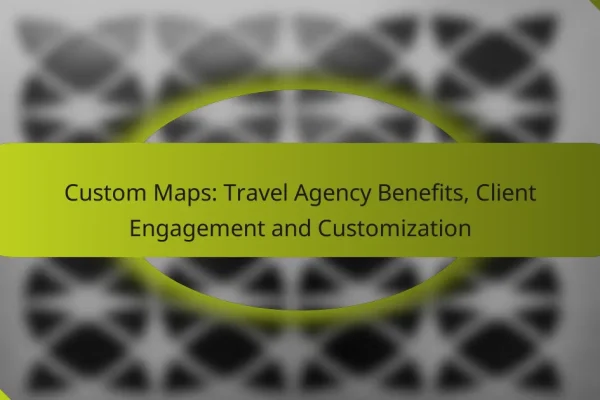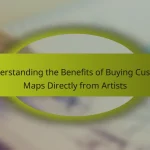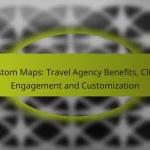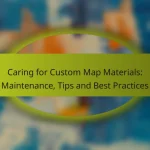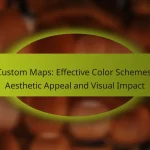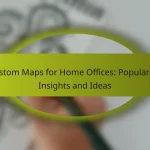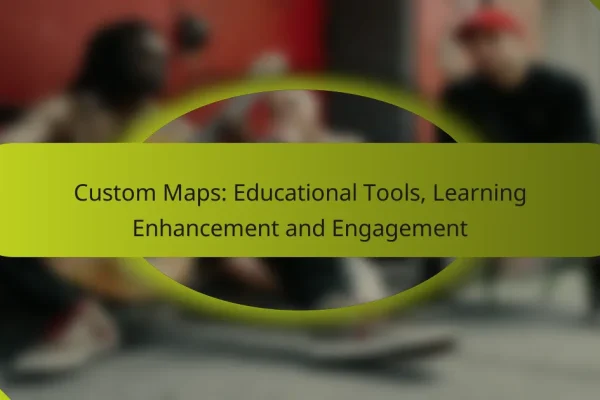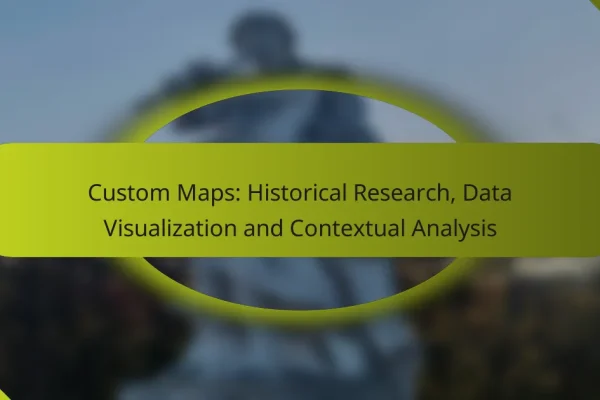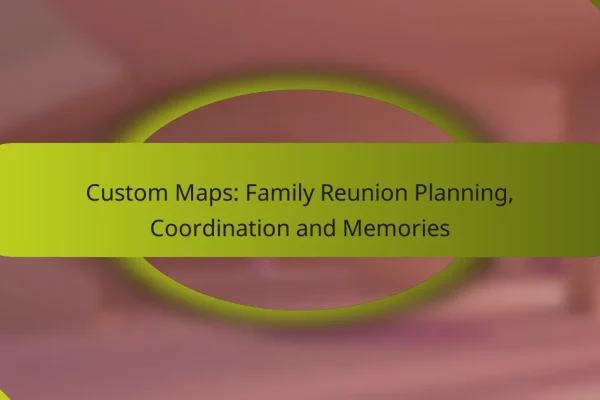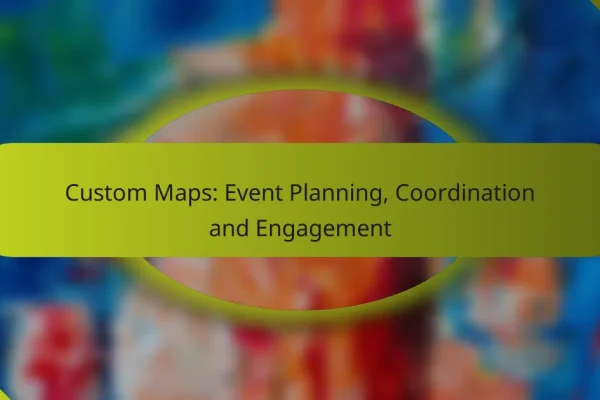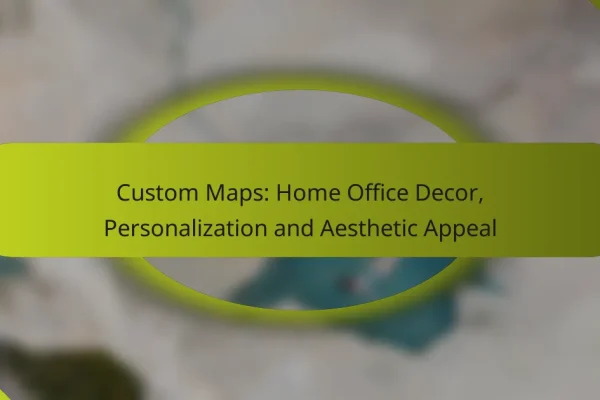How can custom maps enhance local business marketing?
Custom maps can significantly enhance local business marketing by providing targeted, location-specific information that attracts potential customers. They allow businesses to showcase their offerings in relation to local landmarks, making it easier for customers to find and engage with them.
Targeted advertising through location-based maps
Location-based maps enable businesses to create targeted advertising campaigns that reach specific demographics in their area. By integrating geographic data, businesses can identify high-traffic areas and tailor their promotions to attract foot traffic. For example, a restaurant might highlight special offers on a map that appears when users are nearby.
Using tools like Google My Business, companies can ensure their locations are marked accurately, enhancing visibility. This targeted approach can lead to higher conversion rates, as potential customers are more likely to respond to promotions relevant to their immediate surroundings.
Visual storytelling for community engagement
Custom maps can serve as powerful visual storytelling tools that foster community engagement. By incorporating local history, cultural landmarks, and community events, businesses can create narratives that resonate with residents and visitors alike. For instance, a local bookstore might feature a map that highlights literary landmarks in the area.
This approach not only promotes the business but also strengthens community ties. Engaging storytelling through maps can encourage customers to explore the area, increasing foot traffic to local shops and services.
Custom promotions using map features
Businesses can leverage custom map features to create unique promotions that attract customers. For example, a coffee shop could offer a discount to customers who check in at their location via a map app. This not only incentivizes visits but also encourages social sharing, amplifying the promotion’s reach.
Additionally, businesses can use map layers to highlight seasonal promotions or events, making it easy for customers to find relevant offers. By regularly updating these features, businesses can keep their marketing fresh and engaging, driving repeat visits and customer loyalty.
What are the benefits of using custom maps for events?
Custom maps for events provide significant advantages, including improved navigation, tailored experiences for attendees, and increased visibility for sponsors. These maps can enhance the overall event experience by guiding participants effectively and showcasing key areas of interest.
Improved attendee navigation
Custom maps streamline attendee navigation by clearly marking important locations such as registration desks, session rooms, and rest areas. This clarity helps participants find their way quickly, reducing confusion and enhancing their overall experience.
Consider incorporating color coding or icons to represent different areas or activities. This visual differentiation can help attendees orient themselves and plan their schedules efficiently, leading to a more organized event.
Personalized experiences for participants
Custom maps can be tailored to reflect the interests and needs of specific attendee groups, creating a more engaging experience. For instance, maps can highlight networking zones or areas of particular interest, such as workshops or exhibitions.
By allowing attendees to customize their map view based on their preferences, you can enhance their interaction with the event. This personalization can lead to higher satisfaction rates and increased participation in various activities.
Enhanced sponsorship visibility
Custom maps provide an excellent platform for showcasing sponsors by prominently displaying their logos and booth locations. This visibility can significantly increase sponsor engagement and brand recognition during the event.
Consider integrating sponsor advertisements directly into the map design, ensuring they are strategically placed near relevant areas. This approach not only benefits sponsors but also guides attendees to key locations, creating a win-win situation for both parties.
How do custom maps aid in real estate marketing?
Custom maps enhance real estate marketing by providing clear visual representations of property locations and surrounding amenities. They help potential buyers understand the context of a property, making it easier to visualize living in the area.
Showcasing property locations effectively
Custom maps allow real estate agents to pinpoint property locations with precision, making it easier for buyers to find listings. By integrating map features, such as satellite imagery or street views, agents can provide a comprehensive view of the property’s surroundings.
Consider using markers or icons to represent different properties on the map. This visual approach can help buyers quickly identify available homes in their desired neighborhoods.
Highlighting neighborhood amenities
Custom maps can highlight essential neighborhood amenities, such as schools, parks, shopping centers, and public transport options. This information is crucial for buyers who prioritize proximity to these facilities when choosing a home.
Incorporating layers that display various amenities can enhance the map’s utility. For instance, a map could show schools within a certain radius of a property, helping families assess educational options nearby.
Interactive property tours
Interactive maps can facilitate virtual property tours, allowing potential buyers to explore listings from the comfort of their homes. By integrating multimedia elements, such as photos and videos, these maps can create an engaging experience.
To maximize effectiveness, ensure the interactive features are user-friendly and accessible across devices. This approach can significantly increase interest in properties, especially among remote buyers.
What features should I consider when choosing a custom map service?
When selecting a custom map service, prioritize features like user-friendliness, integration capabilities, and customization options. These elements significantly impact how effectively the map can serve your specific needs and enhance user experience.
User-friendly interface
A user-friendly interface is crucial for ensuring that both developers and end-users can easily navigate and utilize the map. Look for services that offer intuitive design, straightforward controls, and clear documentation. This will reduce the learning curve and improve overall satisfaction.
Consider testing the interface with potential users to gather feedback. A simple layout with easily accessible features can make a significant difference in how effectively the map serves its purpose.
Integration with existing platforms
Integration capabilities are essential for a seamless experience. Ensure that the custom map service can easily connect with your existing platforms, such as websites, mobile apps, or CRM systems. This will allow for better data sharing and functionality.
Check for available APIs and plugins that facilitate integration. Services that support popular frameworks or have robust documentation for developers will save time and resources during implementation.
Customization options and scalability
Customization options allow you to tailor the map to fit your specific requirements, such as branding, style, and data layers. Look for services that offer a variety of customization tools, enabling you to create a unique user experience.
Scalability is also important; choose a service that can grow with your needs. Whether you anticipate increased traffic or additional features, ensure the service can handle expansion without compromising performance.
How can custom maps improve tourism experiences?
Custom maps enhance tourism experiences by providing tailored navigation and information that cater to specific interests and needs of travelers. These maps can highlight attractions, routes, and local insights, making exploration more engaging and efficient.
Guided tours with interactive elements
Interactive custom maps can transform guided tours by integrating multimedia elements such as audio guides, videos, and augmented reality features. This approach allows visitors to engage with the content actively, enhancing their understanding of the sites they visit.
For example, a map could include QR codes at various locations that link to historical narratives or personal stories from locals, enriching the tour experience. Consider using platforms that allow easy updates to keep the content fresh and relevant.
Local attractions and hidden gems
Custom maps can effectively showcase local attractions and hidden gems that might not be included in standard tourist guides. By focusing on niche interests, such as street art, local cuisine, or unique cultural experiences, these maps can lead tourists to discover lesser-known spots.
Travelers can benefit from curated lists of recommended restaurants, parks, and community events, providing a more authentic experience. Collaborating with local businesses to feature their offerings can create a win-win situation, boosting tourism while supporting the community.
Multilingual support for diverse visitors
Offering multilingual support on custom maps can significantly enhance accessibility for international tourists. By providing information in multiple languages, destinations can cater to a broader audience, ensuring that language barriers do not hinder exploration.
Implementing this feature may involve translating map content and ensuring that navigation instructions are clear and easy to follow. Consider using professional translation services to maintain accuracy and cultural relevance, which can greatly improve the overall visitor experience.
What are the use cases for custom maps in education?
Custom maps serve various educational purposes, enhancing learning experiences through tailored visual representations. They can be utilized for interactive learning, historical analysis, and practical planning, making them versatile tools in the classroom.
Interactive learning tools for geography
Custom maps can transform geography lessons into engaging, interactive experiences. By incorporating elements like clickable regions or embedded multimedia, educators can create dynamic lessons that encourage student participation and exploration.
For instance, a teacher might design a map that allows students to click on different countries to learn about their cultures, climates, and geographical features. This hands-on approach can significantly enhance retention and understanding.
Visual aids for historical events
Custom maps can effectively illustrate historical events by providing a spatial context that enhances comprehension. For example, educators can create maps that show the progression of wars, migrations, or trade routes, allowing students to visualize the impact of geography on historical developments.
Using a timeline alongside a custom map can further enrich the learning experience, helping students connect events with specific locations and understand their significance in a broader context.
Field trip planning and logistics
Custom maps are invaluable for planning educational field trips, helping educators visualize routes, points of interest, and logistical details. By marking key locations on a map, teachers can streamline the planning process and ensure that all necessary stops are included.
Additionally, these maps can be shared with students and parents, providing clear directions and information about the trip. Incorporating local landmarks and historical sites can also enhance the educational value of the outing, making it more relevant to the curriculum.
